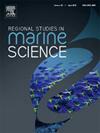Robust and precise drowning target localization under dual-parameters uncertainty
IF 2.1
4区 环境科学与生态学
Q3 ECOLOGY
引用次数: 0
Abstract
To fulfil sustainable and healthy development of the ocean, this paper studied received signal strength (RSS)-based three-dimensional (3D) drowning target localization that simultaneously considering absorption effect, uncertain transmission power (UTP), and time-varying path loss exponent (PLE) for underwater search and rescue missions induced by the frequent occurrence of maritime accidents. Firstly, the original non-linear and non-convex localization problem is transformed into an alternating non-negative constrained least-squares (ANCLS) framework by applying the Taylor first-order expansion and certain approximations. Subsequently, a Robust and Precise Drowning Target Localization (RPDTL) algorithm is then proposed to solve the optimal solution with unknown multi-parameters. The coarse phase of localization is based upon the Golub-Kahan bi-diagonalized least square minimal residual (LSMR) algorithm. Nevertheless, LSMR usually only converges quickly to the local optimal solution. Consequently, an innovative solution method, namely the Broyden-Fletcher-Goldfarb-Shanno (BFGS) trust domain method, is involved in the fine localization phase, where the approximation of the Hessian Matrix is updated through the BFGS formula that significantly reduces the computational cost and saves the computational time. The underwater target location, UTP and PLE are refined simultaneously in the iteration, in which the rough solution acquired using Golub-Kahan bi-diagonalized LSMR is adopted as the initiation. Furthermore, to demonstrate the superiority of RPDTL, we have analyzed the computational complexity and derived the Cramér-Rao lower bound (CRLB). Finally, compared with the selected benchmark algorithms, the simulation results validate that the RPDTL achieves optimal localization accuracy over variable scenarios, which indicates that RPDTL can effectively support the realization of the long-term goal of sustainable ocean health.
求助全文
约1分钟内获得全文
求助全文
来源期刊

Regional Studies in Marine Science
Agricultural and Biological Sciences-Ecology, Evolution, Behavior and Systematics
CiteScore
3.90
自引率
4.80%
发文量
336
审稿时长
69 days
期刊介绍:
REGIONAL STUDIES IN MARINE SCIENCE will publish scientifically sound papers on regional aspects of maritime and marine resources in estuaries, coastal zones, continental shelf, the seas and oceans.
 求助内容:
求助内容: 应助结果提醒方式:
应助结果提醒方式:


